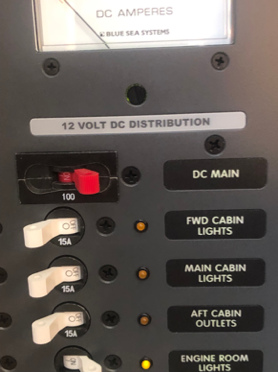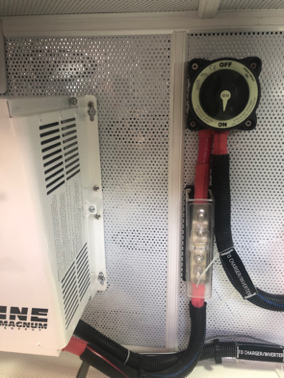Automatic Charging Relays & Remote Battery Switches
By Van Helker
Owners of Helmsman Trawlers have heard clacks emanating from the engine room after they’ve shut down their engine and plugged into shore power, and some have asked about the cause. This article will describe the cause of the clack, better known as an Automatic Charging Relay, and detail the operation of ACRs and their counterpart, the Remote Battery Switch.
Overview
Helmsman Trawlers are equipped with multiple banks of batteries: a house bank, an engine start battery, a bow-thruster/windlass battery, and a generator start battery (if a generator is installed). Automatic Charging Relays, installed on Helmsman Trawlers since 2012, are devices which automatically combine for charging, or isolate for protection, these different battery banks without any thought by the boat operator. They combine banks when a charging current is present so that all batteries benefit from the charging source, and isolate the different battery banks when voltage levels on any bank drops below a certain threshold to ensure that a load on one bank doesn’t drain all the banks.
In the past, managing the charging and isolation of these battery banks was a manual process involving rotary-style battery switches or manually-activated jumper relays to combine and isolate the batteries. This process was easy to forget, and could lead to the inadvertent discharge of the engine start battery – bad news when it was time to start the engine. Current Helmsman Trawlers are equipped with Blue Sea Automatic Charging Relays (ACRs) to link battery banks. When used properly, ACRs eliminate the concern of inadvertently draining the engine start, bow thruster, or generator start batteries by leaving on a coffee maker or other electric device while at anchor.
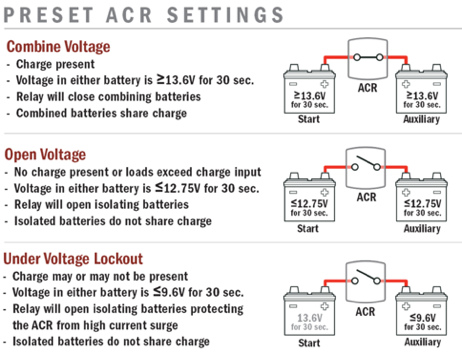
More About Automatic Mode
ACRs are most commonly used in automaticmode. In automaticmode, the ACR will link the boat’s battery banks when a charging current is present. The charging source could be shore-power, the alternator, generator, solar, etc. This ensures that all battery banks receive the benefit of a charging current. In automatic mode ACRs also automatically isolate battery banks when charging has stopped and battery voltage begins to fall. This feature means that a heavy load inadvertently left on, such as an electric coffee maker running on the inverter will only discharge the house bank but not the engine start battery, bow-thruster/windlass battery, and generator battery. In this scenario the engine start battery and generator start battery would be unaffected and could be used to start the engine or generator, which in turn could be used to recharge the house bank.
An ACR is set to automatic operation by positioning the remote switch at the power panel to the middle position. When setting an ACR to automatic operation it may flash for a period of time (~10-90 seconds) while it analyzes voltage levels and searches for charging current. After this period of time has passed it will either open (which will isolate the battery banks) or close (which will combine the battery banks).

Using the Remote Switch to Combine / Disconnect Banks
In addition to setting automatic operation, battery banks can be combined or isolated as desired using the ACR remote switch. When the remote switch is set to “ON” the upper LED will light indicating that banks are combined. When switched to “OFF” the lower LED will light indicating the banks are disconnected. There are situations where it is useful to manually combine banks and to exit automatic mode:
- After extended use of the bow thruster the thruster battery voltage will decline, and the thruster power will drop. Switch the Bow Thruster / Windlass ACR to “ON” to combine banks and provide the thruster with additional battery power.
- If a start battery’s voltage is low and insufficient to start the generator or engine, select “ON” to combine it with another bank. This should be sufficient to start the generator/engine provided there is sufficient charge in the other battery banks.
Manual Control Override Knob
The ACRs can also be controlled with the yellow manual control override knob located on the top of the ACR. This override allows the ACR to be set to “ON” or “OFF” even in the absence of power. Additionally, the ACR can be manually locked out to prevent remote operation by rotating the override knob to the right. This is useful during servicing and for long-term storage. When locked out the ACR remote switch will double blink.
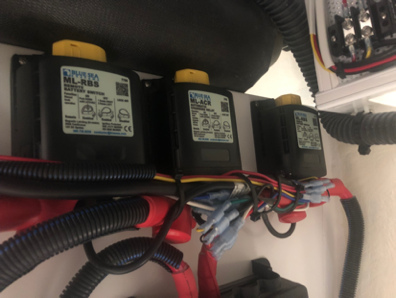
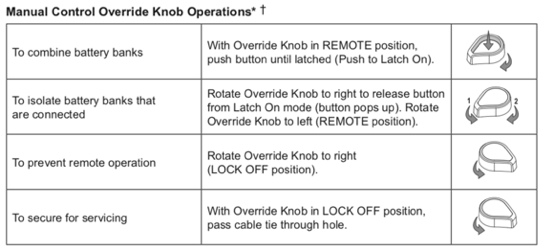
Remote Battery Switches - Similar but Different
The Remote Battery Switch (RBS) is worth mentioning due to their similar operation and appearance to ACRs, however, they serve a different function. RBSs allow for the convenient switching on and off of battery banks or other heavy loads from the power panel location via a remote switch for situations where it would be impractical to run long large gauge cable through the power panel. The remote switch at the power panel controls a solenoid-controlled relay in the vicinity of the battery to open or close.
Remote Battery Switches - Manual Control
Like ACRs, RBSs can also be controlled manually with the yellow manual control override knob located on the top of the RBS. This override allows the RBS to be set to “ON” or “OFF” even in the absence of power or if the remote switch fails. The RBS can be manually locked out to prevent remote operation by rotating the override knob to the right. This is useful for servicing and for long-term storage.
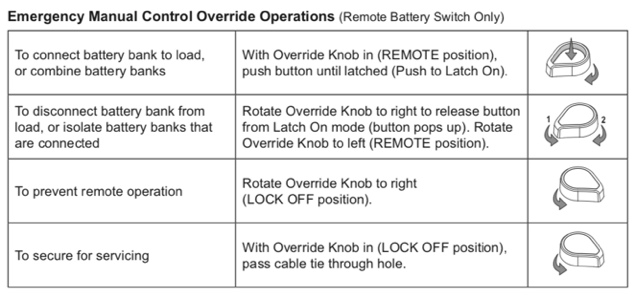
Typical Locations of ACRs & RBSs
The following is a typical list of ACR and RBS locations on Helmsman Trawlers.
Bow Thruster/Windlass ACR & RBS. Located under the master berth
Engine Start Battery ACR & RBS. Located in proximity to the engine start battery, usually on the starboard side of the engine room
House Battery Bank RBS. Located in proximity to the house battery bank, usually on the port side of the machinery space
Generator Start Battery ACR & RBS. Located in proximity to the generator
Stern Thruster RBS. Located in the lazarette
Applying ACR/RBS Knowledge & Preparing Batteries for Long-term Storage
You can further apply your ACR and RBS knowledge if it is necessary to haul out your boat and store it on the hard for extended periods of time (e.g., winter). Adherence to this checklist will help ensure that your batteries are not completely discharged and subsequently damaged during storage:
- Turn off all ACRs and RBSs
- Manually lock open the ACRs and RBSs by turning the yellow tops counterclockwise, ensure that all have been locked out
- Open the red DC panel breaker (see figure 6)
- Turn off inverter rotary breaker switch in engine room (see figure 7)
- Turn all bilge pump and shower sump switches to off
- Reverse the order after storing and prior to returning your boat to the water
